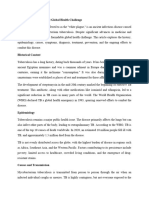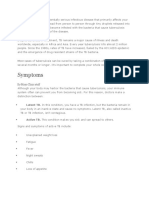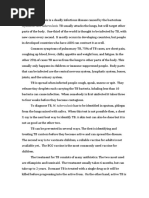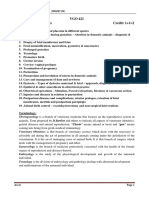0 ratings0% found this document useful (0 votes)
13 viewsThe Silent Killer
The Silent Killer
Uploaded by
sourav1980sffCopyright:
© All Rights Reserved
Available Formats
Download as PDF, TXT or read online from Scribd
The Silent Killer
The Silent Killer
Uploaded by
sourav1980sff0 ratings0% found this document useful (0 votes)
13 views18 pagesOriginal Title
TB
Copyright
© © All Rights Reserved
Available Formats
PDF, TXT or read online from Scribd
Share this document
Did you find this document useful?
Is this content inappropriate?
Copyright:
© All Rights Reserved
Available Formats
Download as PDF, TXT or read online from Scribd
Download as pdf or txt
0 ratings0% found this document useful (0 votes)
13 views18 pagesThe Silent Killer
The Silent Killer
Uploaded by
sourav1980sffCopyright:
© All Rights Reserved
Available Formats
Download as PDF, TXT or read online from Scribd
Download as pdf or txt
You are on page 1of 18
TB
THE SILENT KILLER
NAME :- SAURAV
TH
CLASS :- 11 A
STUDENT ID :-
20180267787
SCHOOL :- GBSSS A-BLOCK
JANAKPURI
TOPICS:
• Introduction • Types of Tuberculosis
• What is Tuberculosis? • Treating Tuberculosis
• Causes of Tuberculosis • Preventing Tuberculosis
• How does Tuberculosis • Tuberculosis in children
spread • Global impact of
• Symptoms of Tuberculosis
Tuberculosis
Introduction
Tuberculosis, also known as TB, is a serious
disease that affects millions of people around
the world. It is caused by a bacteria that can
spread from person to person through the air
when someone with TB coughs or sneezes.
TB primarily affects the lungs, but it can also
affect other parts of the body such as the
kidneys and brain.
Understanding the causes, symptoms, and
prevention methods of TB is crucial for
controlling the spread of the disease. TB can
be fatal if left untreated, and drug-resistant
strains of the bacteria are becoming more
common. By learning about TB and taking
steps to prevent its spread, we can help
protect ourselves and our communities from
this dangerous disease.
What is Tuberculosis?
Tuberculosis, commonly known as TB, is a
bacterial infection that primarily affects the
lungs. It can also affect other parts of the body
such as the brain, spine, and kidneys. TB is
spread through the air when an infected
person coughs or sneezes. When someone
breathes in the bacteria, they can become
infected.
Once inside the body, the bacteria can multiply
and cause damage to the organs it infects.
Symptoms of TB include coughing, fever, night
sweats, and weight loss. It's important to get
tested for TB if you have been exposed to
someone with the disease or if you have
symptoms. Early diagnosis and treatment can
prevent the spread of TB and improve
outcomes for those who are infected.
Causes of Tuberculosis
Tuberculosis is caused by a bacterium called
Mycobacterium tuberculosis. This bacterium
spreads from person to person through the air
when an infected person coughs or sneezes.
When someone breathes in these bacteria,
they can settle in the lungs and begin to
multiply, causing the disease to develop.
While anyone can get Tuberculosis, certain
factors can increase the risk of infection.
These include weakened immune systems,
such as those with HIV or diabetes, living or
working in crowded conditions, and being in
close contact with someone who has the
disease. It's important to understand these
risk factors in order to take steps to prevent
the spread of Tuberculosis.
How does Tuberculosis spread?
Tuberculosis (TB) is a highly infectious disease caused by the bacterium
Mycobacterium tuberculosis. It primarily affects the lungs but can also affect
other parts of the body such as the kidneys, spine, and brain.
TB is spread through the air when an infected person coughs, sneezes, or
talks. This releases droplets containing the bacteria into the air, which can be
inhaled by others. The disease is more likely to be transmitted in enclosed
spaces with poor ventilation, such as crowded living quarters or hospitals.
Certain populations are more vulnerable to TB, including those with
weakened immune systems such as people living with HIV/AIDS,
malnourished individuals, and the elderly. Additionally, individuals who live
in poverty, overcrowded conditions, or have limited access to healthcare are
at a higher risk of contracting TB.
Symptoms of Tuberculosis
Tuberculosis is a serious disease that can
have devastating effects on individuals and
communities. The most common symptoms
of Tuberculosis include coughing, fever, and
weight loss. But these symptoms are just the
tip of the iceberg.
Tuberculosis can also cause night sweats,
fatigue, and chest pain. In some cases, the
disease can even spread to other parts of the
body, such as the kidneys or spine. And for
those with weakened immune systems, like
children and HIV-positive individuals,
Tuberculosis can be especially dangerous.
Types of Tuberculosis
Tuberculosis can be classified into two main types: latent TB infection and
active TB disease. Latent TB infection means that the bacteria are present in
the body but are not causing any symptoms. Active TB disease, on the other
hand, means that the bacteria are causing symptoms and can be spread to
others.
Drug-resistant TB is a type of TB that is resistant to one or more of the
standard TB drugs. This type of TB is much harder to treat and requires
more expensive and prolonged treatment regimens. Drug-resistant TB is a
serious public health threat, especially in countries with high rates of TB and
limited resources for treatment.
Treating Tuberculosis
The main treatments for Tuberculosis are
antibiotics and a combination of drugs.
Treatment can last anywhere from six months
to two years, depending on the severity of
the disease and the patient's response to
treatment. It's important to complete the full
treatment course, even if symptoms improve,
to prevent the development of drug-resistant
strains of the disease.
Antibiotics work by killing the bacteria
responsible for Tuberculosis. The most
commonly used antibiotics for Tuberculosis
are isoniazid, rifampin, ethambutol, and
pyrazinamide. These drugs are usually taken
in combination to prevent the development
of drug-resistant strains. In some cases,
surgery may be necessary to remove infected
tissue.
Preventing Tuberculosis
Prevention is key in the fight against
Tuberculosis. Vaccination is one of the most
effective ways to prevent the disease, and it is
recommended for people who are at high risk
of contracting Tuberculosis. Good hygiene
practices, such as covering your mouth when
you cough or sneeze, can also help prevent the
spread of the disease.
In some parts of the world, vaccination
programs have been successful in reducing the
incidence of Tuberculosis. For example, in the
United States, the BCG vaccine is given to
infants and children who are at high risk of
contracting the disease. In addition, public
health campaigns have emphasized the
importance of good hygiene practices, such as
handwashing and covering your mouth when
you cough or sneeze.
Tuberculosis in children
Tuberculosis is a disease that can affect anyone,
including children. In fact, children are more
vulnerable to the disease than adults because
their immune systems are not fully developed.
Children who live in areas with high rates of
Tuberculosis are at risk of contracting the disease,
especially if they have close contact with
someone who is infected.
The symptoms of Tuberculosis in children are
similar to those in adults, but they may be less
severe. Children with Tuberculosis may
experience a persistent cough, fever, and weight
loss. They may also have difficulty breathing and
feel tired all the time. It is important to diagnose
and treat Tuberculosis in children as soon as
possible to prevent serious complications.
Global Impact of Tuberculosis
Tuberculosis is a global health problem that affects
millions of people every year. In 2019, there were an
estimated 10 million cases of Tuberculosis worldwide, with
1.4 million deaths attributed to the disease. This makes
Tuberculosis one of the top 10 causes of death globally.
The impact of Tuberculosis is particularly severe in low-
and middle-income countries, where access to healthcare
and resources for prevention and treatment are limited. In
these countries, Tuberculosis often goes undiagnosed and
untreated, leading to high rates of morbidity and mortality.
Additionally, Tuberculosis has a significant economic impact,
as it can lead to lost productivity and increased healthcare
costs.
Conclusion
In conclusion, Tuberculosis is a serious global health issue that
requires urgent attention. We have learned about the causes,
symptoms, and prevention methods of Tuberculosis, as well as
the challenges in controlling the disease. It is clear that
Tuberculosis has a significant impact on individuals,
communities, and healthcare systems around the world.
To address this problem, we must prioritize Tuberculosis control
efforts, including increased funding for research and
development of new treatments and vaccines. We must also
work to improve access to diagnosis and treatment, particularly
in low-resource settings. And finally, we must raise awareness
about the importance of prevention, including vaccination and
good hygiene practices.
You might also like
- AnatomyDocument6 pagesAnatomyKadulum100% (1)
- Article PPT Slogan ReportDocument43 pagesArticle PPT Slogan Reportsourav1980sffNo ratings yet
- TuberculosisDocument5 pagesTuberculosisfeelingthisbadneverfeltsogreatNo ratings yet
- 1.8 Million: What Is Tuberculosis?Document9 pages1.8 Million: What Is Tuberculosis?rahayusri yayuNo ratings yet
- Tube Rcul Osis: Prepared byDocument11 pagesTube Rcul Osis: Prepared byBal Ri MekoleuNo ratings yet
- Tuberculosis DocxxDocument9 pagesTuberculosis Docxxantony wamunyuNo ratings yet
- TB - OutlineDocument11 pagesTB - Outlinekent yeeNo ratings yet
- Tuberculosis: Medical DictionaryDocument5 pagesTuberculosis: Medical DictionarydennisgdagoocNo ratings yet
- FB3 - 13-Sudeep Koirala-TuberculosisDocument29 pagesFB3 - 13-Sudeep Koirala-Tuberculosisvaskar_karkiNo ratings yet
- 1 - TBDocument36 pages1 - TBAkshayaa GanesanNo ratings yet
- BAHASA - INGGRIS ArtikelDocument4 pagesBAHASA - INGGRIS Artikelindah abdullahNo ratings yet
- Wepik Tuberculosis 202310051513168cx6Document12 pagesWepik Tuberculosis 202310051513168cx6sriya.beura2007No ratings yet
- Wepik Unmasking Tuberculosis An in Depth Analysis of A Global Health Challenge 20231102103011i5rwDocument15 pagesWepik Unmasking Tuberculosis An in Depth Analysis of A Global Health Challenge 20231102103011i5rwmyselfsanjayrNo ratings yet
- Sneezing: TransmissionDocument13 pagesSneezing: TransmissionMuzammal MollahNo ratings yet
- DefinitionDocument3 pagesDefinitionrahayusri yayuNo ratings yet
- TB in Children - Getting, Diagnosing, Preventing TB: TB/HIV Co-InfectionDocument10 pagesTB in Children - Getting, Diagnosing, Preventing TB: TB/HIV Co-InfectionKirt Earl RicardoNo ratings yet
- Foundation in Science: Biology IiiDocument63 pagesFoundation in Science: Biology IiiLeong Sze XieNo ratings yet
- Dengue FeverDocument4 pagesDengue FeverDez TabiosNo ratings yet
- Presentation 1Document12 pagesPresentation 1farzana8No ratings yet
- Tory O: NameDocument17 pagesTory O: Namejana champakNo ratings yet
- TUBERCULOSISDocument7 pagesTUBERCULOSISWilmer PorrasNo ratings yet
- Paper Analisis HL BlumDocument10 pagesPaper Analisis HL BlumRegina MarshaNo ratings yet
- TuberculosisDocument23 pagesTuberculosisKeertana RajagopalNo ratings yet
- TUBERCULOSISDocument4 pagesTUBERCULOSISamirNo ratings yet
- TuberculosisDocument8 pagesTuberculosisArathi KarshNo ratings yet
- TUBERCULOSISDocument6 pagesTUBERCULOSISByzid ByzidNo ratings yet
- What Causes Tuberculosis?: Who Is at Risk?Document6 pagesWhat Causes Tuberculosis?: Who Is at Risk?Puskesmas GondangNo ratings yet
- TuberculosisDocument21 pagesTuberculosisTEH KAI SHIN MoeNo ratings yet
- Erregersteckbrief en de DataDocument2 pagesErregersteckbrief en de DataDescargar scribdNo ratings yet
- Bio PresentationDocument14 pagesBio PresentationSyah IskandarNo ratings yet
- Mantoux test-TSTDocument13 pagesMantoux test-TSTNektarios TsakalosNo ratings yet
- What Is TuberculosisDocument6 pagesWhat Is Tuberculosissachin002kypNo ratings yet
- TUBERCULOSISDocument47 pagesTUBERCULOSISIfeoluwa Deborah Olopade100% (1)
- TUBERCULOSISDocument5 pagesTUBERCULOSISindonesiaserverid0003No ratings yet
- Infectious Diseases: I. BackgroundDocument3 pagesInfectious Diseases: I. Backgroundsaras qtNo ratings yet
- Avni Gupta - PPT On TuberculosisDocument12 pagesAvni Gupta - PPT On TuberculosisAvni GuptaNo ratings yet
- TBDocument1 pageTBshahzaib shoukatNo ratings yet
- Tuberculosis. English EssayDocument2 pagesTuberculosis. English EssayAdri BenavidesNo ratings yet
- TuberculosisDocument4 pagesTuberculosisHadish BekuretsionNo ratings yet
- Symptoms: by Mayo Clinic StaffDocument32 pagesSymptoms: by Mayo Clinic StaffLourghem Libut FerrerNo ratings yet
- Sample Term Paper About TuberculosisDocument4 pagesSample Term Paper About Tuberculosisea7gpeqm100% (1)
- Tuberculosis PaperDocument2 pagesTuberculosis PaperpranastyNo ratings yet
- Epidemiology of Tuberculosis DR Lotfi Issa 2022-2023Document52 pagesEpidemiology of Tuberculosis DR Lotfi Issa 2022-2023N.h 999No ratings yet
- Tuberculosis: by Khushi Beniwal Class 11 Queen Convent School Tuberculosis PresentationDocument15 pagesTuberculosis: by Khushi Beniwal Class 11 Queen Convent School Tuberculosis Presentationbeniwalkhushi27No ratings yet
- Chronic Inflammation of The Thin Tissue Lining Each Air Sac Causes Scarring and Makes The Sacs Less FlexibleDocument8 pagesChronic Inflammation of The Thin Tissue Lining Each Air Sac Causes Scarring and Makes The Sacs Less FlexibleRosalina MarilaoNo ratings yet
- Diet and Nutrition in TuberculosisDocument23 pagesDiet and Nutrition in TuberculosisParthPatel100% (1)
- TUBERCULOSISDocument9 pagesTUBERCULOSISRahma WatiNo ratings yet
- Introduction TB Text OnlyDocument8 pagesIntroduction TB Text OnlyjamNo ratings yet
- Communicable Disease - Edited.....Document7 pagesCommunicable Disease - Edited.....Research GuruNo ratings yet
- Bio PresentationpDocument14 pagesBio PresentationpSyah IskandarNo ratings yet
- Hard BoundDocument369 pagesHard BoundClang SantiagoNo ratings yet
- TuberculosisDocument6 pagesTuberculosisANGELINE CHRYSTABELNo ratings yet
- Group Tuberculosis Written ReportDocument7 pagesGroup Tuberculosis Written ReportEricka ParaisoNo ratings yet
- The Re-Emergence of Tuberculosis 2Document4 pagesThe Re-Emergence of Tuberculosis 2Navid Ali AskariNo ratings yet
- What Is Tuberculosis?Document1 pageWhat Is Tuberculosis?Rhod Bernaldez EstaNo ratings yet
- Q: What Is TB? How Does It Spread? How Is It Treated?Document1 pageQ: What Is TB? How Does It Spread? How Is It Treated?Rizki NilamsariNo ratings yet
- HealthDocument3 pagesHealthJustine MasagnayNo ratings yet
- HS 2712 LJ Unit 4Document3 pagesHS 2712 LJ Unit 4Adanigbo MagretNo ratings yet
- Presentation R-APDRP Extension Lecture 12th July 2012 BeminaDocument80 pagesPresentation R-APDRP Extension Lecture 12th July 2012 BeminaBilal AhmadNo ratings yet
- Bill of QuantitiesDocument16 pagesBill of Quantitieserickimuyu19No ratings yet
- Latihan Soal PAS BAHASA INGGRISDocument17 pagesLatihan Soal PAS BAHASA INGGRISClevio YosdianaNo ratings yet
- Bruno MarsDocument1 pageBruno MarsMaria MarraNo ratings yet
- كيفية حساب كمية سلك اللحام المطلوبةDocument6 pagesكيفية حساب كمية سلك اللحام المطلوبةMohamed Atef100% (1)
- GE1 Module 13 Setting Goals For SuccessDocument9 pagesGE1 Module 13 Setting Goals For SuccessLysander GarciaNo ratings yet
- Sma Sunny Home Manager Installation ManualDocument77 pagesSma Sunny Home Manager Installation ManualChrisNo ratings yet
- Bahasa Inggris SMA/MA IPS: Questions 1 - 4 DirectionsDocument15 pagesBahasa Inggris SMA/MA IPS: Questions 1 - 4 DirectionsGrace ValenciaNo ratings yet
- Reflection Paper 1301Document2 pagesReflection Paper 1301api-488101934No ratings yet
- PGTRB Commerce Unit 1 Study Material English MediumDocument17 pagesPGTRB Commerce Unit 1 Study Material English MediumG NagarajanNo ratings yet
- VGO 421 ObstetricsDocument159 pagesVGO 421 ObstetricsNaveen BasudeNo ratings yet
- Flesch-Kincaid Grade LevelDocument2 pagesFlesch-Kincaid Grade LevelHamidreza AbdiNo ratings yet
- 5 People V MoraDocument2 pages5 People V MoraCedrickNo ratings yet
- Satyaprakash TJSBDocument3 pagesSatyaprakash TJSBAditya Adi SinghNo ratings yet
- Schmidt 2009Document15 pagesSchmidt 2009hh6281939No ratings yet
- Report Vietfood Beverages 2023Document19 pagesReport Vietfood Beverages 2023Arya KumarNo ratings yet
- Workplace Anger: It's All The Rage: Janet PfeifferDocument9 pagesWorkplace Anger: It's All The Rage: Janet PfeifferCarolina LenisNo ratings yet
- Francis TurbineDocument8 pagesFrancis TurbineMohamad HamimyuddinNo ratings yet
- GRADE 11 PR 1 3rd QTRDocument2 pagesGRADE 11 PR 1 3rd QTRCHERILYN TANTIADONo ratings yet
- CGR-30P Primary Engine MonitorDocument2 pagesCGR-30P Primary Engine MonitorJoel McCammonNo ratings yet
- AIHR HR Metrics Cheat SheetDocument7 pagesAIHR HR Metrics Cheat Sheethcintiland sbyNo ratings yet
- Lincoln County School District # 2 Elementary Lunch Menu January-11Document1 pageLincoln County School District # 2 Elementary Lunch Menu January-11anon-579447No ratings yet
- Wset L3sake Specification en Jun2017Document28 pagesWset L3sake Specification en Jun2017Lee BodiniNo ratings yet
- Stephens & Kray Terms of EngagementDocument2 pagesStephens & Kray Terms of EngagementStephens and KrayNo ratings yet
- Implementation of Sap For Materials Management Module: KHUSHI MUNDRA (RA1811033010054)Document59 pagesImplementation of Sap For Materials Management Module: KHUSHI MUNDRA (RA1811033010054)Olajubu OlatubosunNo ratings yet
- Nota Sains NutritionDocument6 pagesNota Sains NutritionLilavathi GengadoreNo ratings yet
- Chapter 02Document15 pagesChapter 02Koushik DaharNo ratings yet
- Detailed Lesson Plan Capitulo John Gabriel B.Document11 pagesDetailed Lesson Plan Capitulo John Gabriel B.Gabriel CapituloNo ratings yet
- Template Peserta Gol 2Document38 pagesTemplate Peserta Gol 2Ayi Bilal AlfarizNo ratings yet
























































































